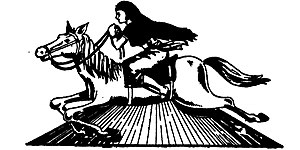Koupalu
| Koupalu (Old Manipuri: ꯀꯧꯄꯂꯨ) | |
|---|---|
Guardian God of the North West Direction | |
| Member of Lainingthous, Maikei Ngaakpa Lais and Umang Lais | |
 "Koupalu", the Ancient Meitei name of God Koubru, written in archaic Meetei Mayek abugida | |
| Other names | Koubaru, Koubru |
| Affiliation | Meitei mythology (Manipuri mythology) and Meitei religion (Sanamahism) |
| Major cult center | Mount Koupalu (Mount Koubru) |
| Abode | Mount Koupalu (Mount Koubru) |
| Weapon | Spear |
| Animals | White elephant |
| Mount | White elephant |
| Texts | PuYas |
| Gender | Male |
| Region | Ancient Kangleipak (Antique Manipur) |
| Ethnic group | Meitei ethnicity |
| Festivals | Koubru Lai Haraoba[1] |
| Personal information | |
| Consorts |
|
| Children |
|
Koupalu (Old Manipuri: ꯀꯧꯄꯂꯨ) or Koubaru (Meitei: ꯀꯧꯕꯔꯨ) or Koubru (Meitei: ꯀꯧꯕ꯭ꯔꯨ) is a God in Meitei mythology and religion of Ancient Kangleipak (Antique Manipur). He is the Guardian of the North West direction (Old Manipuri: ꯀꯧꯄꯂꯨ ꯃꯥꯢꯀꯩ, romanized: Koupalu Maikei, lit. 'Direction of Koupalu').[3][4][5][6] Legend says he is the founder of civilization in Ancient Manipur,[4] starting from the Mount Koubru, a peak where he abodes, in north-western Manipur.[3][6][7][8]
God Koupalu resides in the Mount Koupalu (Mount Koubru). The Mount Koupalu (Mount Koubru) is the first place of settlement of the Meitei ethnicity, including the Lois of Andro, Khurkhul, Phayeng and Sekmai.[3][6]
Origin[edit]
The traditional hymns supplement the theory of origin.
Awang Koubru Assupa
Leimalai Khunda Ahanba.
Nongthrei Ma-U Lingliba,
Irik Mapan Thariba,
Lainingthou!
English translation of the above passage:
North Koubru all-inclusive (pervasive)
Leima Lai first habitation,
Heaven-flower all things seen established,
Blood drop (Blood cell) planters,
O! Lainingthou (King of Gods)![9]
This is the hymn of invocation of God Koubru (Koupalu in PuYas).[9]
Description[edit]
Lord Koubru is the Omniscient and the Omnipotent Guardian God. He lives on the top of Mount Koubru.[10] God Koubru, the Heavenly Lord, is said to be the controller of the nine underground wells/tunnels. These are associated with the birth and death of the mankind. The 9 tunnels are sacred to the Meitei people. So, these are still worshipped by the Meiteis.[11]
Worship[edit]
In the Lai Haraoba festival, a ritualistic folk song dedicated to God Koubru is sung like this:
Awang Koubru Assupa
Eeyen Khunda Ahanba
English translation of the above passage:
Koubru of the North, You are the overlord
You are the first place of settlement.[3][6]
The Meiteis offer a beautiful puppy to God Koubru to free themselves from the sufferings.[3][6] The Loi caste of the Meitei ethnicity worship God Koubru on every occasion, including birth, marriage and death.[3][6] All the Loi villagers excluding Andro are the worshipers of God Koubru.[10]
See also[edit]
References[edit]
- ↑ "Koubru – Manipur News".
- ↑ Oinam, Bhagat; Sadokpam, Dhiren A. (2018-05-11). Northeast India: A Reader. Taylor & Francis. ISBN 978-0-429-95320-0.
- ↑ 3.0 3.1 3.2 3.3 3.4 3.5 Prakash, Col Ved (2007). Encyclopaedia of North-East India. Atlantic Publishers & Dist. ISBN 978-81-269-0706-9.
- ↑ 4.0 4.1 Singh, N. Tombi (1972). Manipur: A Study. Available with Raj Stores.
- ↑ Brara, N. Vijaylakshmi (1998). Politics, Society, and Cosmology in India's North East. Oxford University Press. ISBN 978-0-19-564331-2.
- ↑ 6.0 6.1 6.2 6.3 6.4 6.5 Devi, Lairenlakpam Bino (2002). The Lois of Manipur: Andro, Khurkhul, Phayeng and Sekmai. Mittal Publications. ISBN 978-81-7099-849-5.
- ↑ Devi, Dr Yumlembam Gopi. Glimpses of Manipuri Culture. Lulu.com. ISBN 978-0-359-72919-7.
- ↑ Singh, Kumar Suresh; Horam, M.; Rizvi, S. H. M. (1998). Manipur. Anthropological Survey of India. ISBN 978-81-7046-127-2.
- ↑ 9.0 9.1 Singh, Dr Th Suresh (2014-06-02). The Endless Kabaw Valley: British Created Visious Cycle of Manipur, Burma and India. Quills Ink Publishing. p. 11. ISBN 978-93-84318-00-0.
- ↑ 10.0 10.1 Bareh, Hamlet (2001). Encyclopaedia of North-East India. Mittal Publications. ISBN 978-81-7099-790-0.
- ↑ Singh, Dr Th Suresh (2014-06-02). The Endless Kabaw Valley: British Created Visious Cycle of Manipur, Burma and India. Quills Ink Publishing. p. 12. ISBN 978-93-84318-00-0.
External links[edit]

